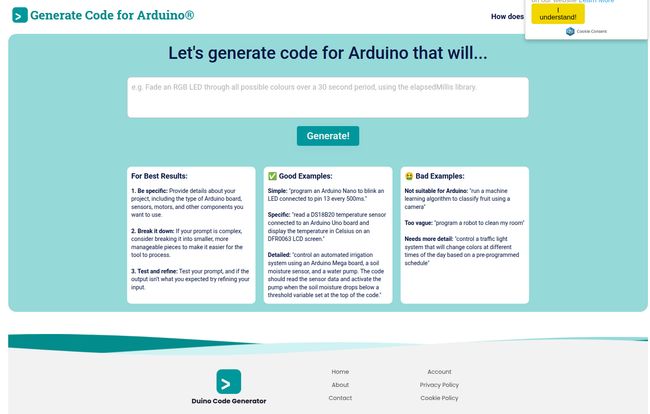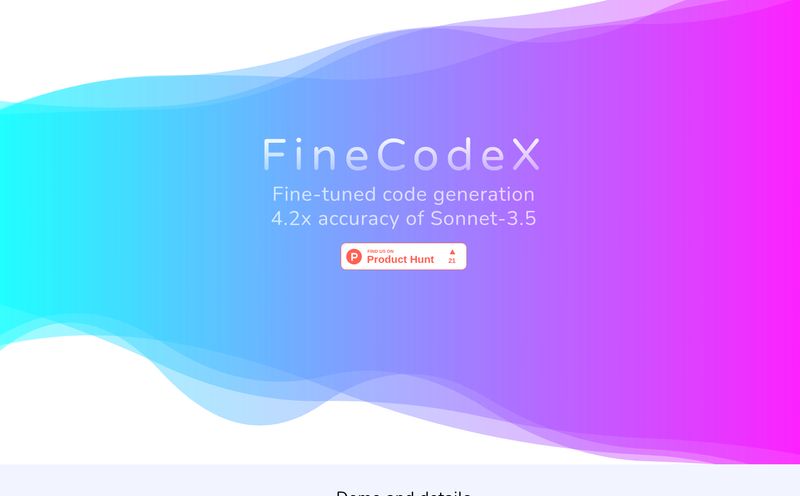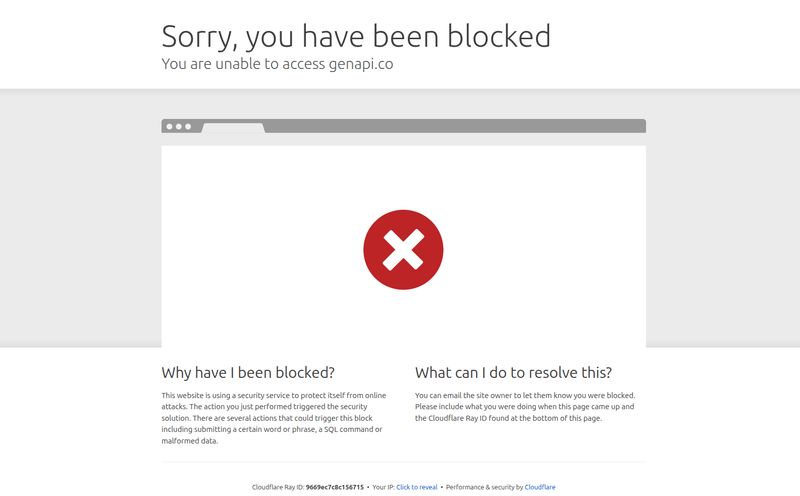If you’ve ever tinkered with an Arduino, you’ve known the unique brand of frustration that comes with a single misplaced semicolon bringing your entire project to a screeching halt. We’ve all been there, staring at a screen of C++ code at 2 AM, fueled by coffee and sheer stubbornness, wondering why our brilliant LED-blinking masterpiece just… won’t… work. The copy-paste-and-pray method from old forum posts is a rite of passage, right?
For years, that's just been the barrier to entry. But now, the AI wave is crashing onto every shore, including the vibrant world of DIY electronics. We're seeing a surge in tools that promise to do the heavy lifting. One that recently caught my eye is the Duino Code Generator. As someone who’s spent years neck-deep in tech trends and traffic generation, I’ve seen my fair share of AI hype. So, does this tool actually lower the barrier, or is it just another shiny object? Let's plug it in and find out.
What Exactly is Duino Code Generator?
At its heart, Duino Code Generator is a translator. You speak to it in plain English, and it speaks back in Arduino-flavored C++. It’s built on OpenAI's GPT-3.5-Turbo, a model I'm sure you've heard of. Think of it as a specialized front-end for ChatGPT, designed specifically for one task: generating code for your Arduino projects.
But don't mistake it for magic. It’s not sentient, and it doesn't understand electronics in the way a human engineer does. It’s a spectacularly powerful pattern-matching machine. It has ingested a mind-boggling amount of text and code from the internet, and when you give it a prompt, it generates what it predicts is the most statistically likely code to match your request. It’s like having a junior developer on call 24/7. They're eager and fast, but you, as the project lead, absolutely need to review their work.

Visit Duino Code Generator
Getting Your Hands Dirty: How to Make it Work for You
Using the tool is simple, but getting good results takes a bit of finesse. The homepage itself gives away the secret sauce, which I appreciate. No black boxes here. It all comes down to how you talk to the AI.
The Art of the Perfect Prompt
This is where most people will trip up. Throwing a vague request at it like "program my robot" is the equivalent of telling a chef to "make food." You'll get something, but probably not what you wanted. Specificity is your best friend. Instead of saying “make an LED blink,” you should say, “program an Arduino Nano to blink the onboard LED connected to pin 13 every 500ms.”
Look at the difference. You’ve specified the board (Nano), the component (LED), the exact pin (13), and the behavior (blink every 500ms). This gives the AI all the puzzle pieces it needs. The more details you provide—sensor models like the DS18B20, the type of screen, which libraries to use—the better your initial code draft will be.
Breaking Down Your Masterpiece
Here’s another pro tip, straight from their site: don't ask it to build your entire four-legged, sensor-laden, autonomous robot in one go. The tool itself admits it's not great for super complex tasks. Think of your project in terms of functions. First, ask for the code to read a soil moisture sensor. Test it. Great. Now, put that aside and ask for the code to activate a water pump for 5 seconds. Test that. Perfect. Now, as the human developer, your job is to stitch those tested, working pieces together. It's a much more reliable workflow.
Test, Tweak, and Tinker
I can't stress this enough: never trust AI-generated code blindly, especially when hardware is involved. The generator’s own footer has a disclaimer about this, and for good reason. The code it produces is a starting point. A fantastic, time-saving, roadblock-smashing starting point, but a starting point nonetheless. You still need to read it, understand what it’s doing, and verify it before uploading it to your precious board. Sometimes it might use a deprecated library or a slightly inefficient method. That's fine! Its job is to get you 90% of teh way there, your job is to carry it over the finish line.
The Good, The Bad, and The Code
So, after playing around with it, what’s the real verdict? Like any tool, it has its brilliant moments and its face-palm moments.
Where It Absolutely Shines
For beginners, this tool is a godsend. It demolishes the initial intimidation factor of a blank Arduino IDE screen. It's an incredible learning aid, allowing you to see how a natural language request translates into actual syntax. I wish I’d had this when I was trying to get my first I2C LCD screen to work; the hours of my life I would have gotten back!
It’s also a powerful accelerator for prototyping. If you’re an experienced dev who just needs a quick snippet for a temperature sensor you haven’t used in a while, it’s much faster than digging through old documentation. It’s the ultimate “un-sticker,” getting you past those minor coding hurdles so you can focus on the bigger picture of your project.
The Reality Check: Its Limitations
Okay, let's ground ourselves. This isn’t going to build a complex machine learning algorithm to sort fruit with a camera, as one of their “bad examples” rightly points out. Its creativity is limited to the patterns it has learned. Because it's running on GPT-3.5-turbo and not a newer model, it might not be up-to-date with the absolute latest libraries or best practices. Some might argue that relying on this hinders real learning, but I disagree. I think it changes what you learn. You learn to be a better system integrator and a code reviewer, which are arguably more valuable skills these days.
The biggest con is the one that’s also its greatest strength: it requires a human. You are the quality control. You are the final check. This is not a fire-and-forget missile for code; it's a coding co-pilot, and you're still the one flying the plane.
So, What's the Price for This AI Magic?
This is usually the part of the review where I break down subscription tiers and pricing plans. But here’s the interesting thing: as of right now, Duino Code Generator appears to be completely free to use. I couldn't find a pricing page or any mention of a cost. How do they keep the lights on? My professional guess, looking at the footer, is through their Amazon Associates link. When they suggest components or if you click through, they likely get a small commission. It’s a smart, unobtrusive way to fund a useful community tool, and I respect that.
Who is This Tool Really For?
This isn't a one-size-fits-all solution. Its value really depends on who you are.
- For Hobbyists and Complete Beginners: This is an absolute 10/10. It’s the friendly guide you need to get started and see results fast, which is a huge motivator.
- For Students and Educators: It's a fantastic teaching instrument. An instructor could use it to instantly generate examples or have students compare their own code to the AI's output.
- For Experienced Developers: It's a handy utility. A time-saver for generating boilerplate code for common tasks. You won't use it to architect your whole system, but you'll definitely use it for the little bits and pieces. It's another tool in the toolbox.
Frequently Asked Questions About Duino Code Generator
- Is Duino Code Generator really free to use?
- Yes, based on all the information on their website, the tool is currently free to use. They seem to be supported by affiliate programs.
- What AI model does it use?
- The site states that it uses GPT-3.5-Turbo from OpenAI, a well-known and powerful large language model.
- Can it generate code for any Arduino project?
- No. It's best for simple to moderately complex tasks. For highly complex projects like robotics with advanced AI, you should use it to generate code for individual components (like moving a single servo or reading a sensor) and then integrate that code yourself.
- Do I need to know how to code to use it?
- To generate the initial code, no. But to successfully get your project working, yes, you'll need at least a basic understanding. You must be able to review the code, troubleshoot, and understand how to upload it to your board. It helps you learn, it doesn't remove the need to.
- Is the generated code safe to upload to my board?
- You must review it first! While the code is often correct, an AI can make mistakes that could potentially damage your hardware (e.g., setting a pin to both HIGH and LOW output incorrectly). Always read and understand the code before you upload.
- How is this different from just asking ChatGPT?
- While the underlying tech is similar, Duino Code Generator provides a focused, streamlined interface specifically for Arduino. It removes the 'chattiness' of ChatGPT and gets straight to the point, with on-page examples and guidance tailored to electronics projects.
My Final Verdict
So, is Duino Code Generator a gimmick or a game-changer? In my experience, it's a bit of both, in the best way possible. It’s not an autonomous robot developer that will put engineers out of a job. But it is a powerful assistant that dramatically speeds up workflow, makes hardware more accessible to newcomers, and makes the whole process of tinkering more fun and less frustrating. It's a friendly ghost in the machine, helping you get your ideas from your brain into the real world.
It represents a shift from writing every line of code by hand to becoming a curator and integrator of code. And frankly, in our increasingly complex world, that's an incredibly valuable skill. Give it a spin, but keep your brain switched on. Happy tinkering.



